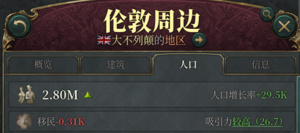移民是指人群在国家之间的流动。
移民种类
维多利亚3中有两种移民。
- 市场内移民是两个在同一市场的国家之间的人群的流动。人权法律决定了谁可以在市场里移民,自由人(无移民控制)、非受歧视人群(移民控制)或者不可移民(关闭边境)。根据两个省份的当地基础设施和市场接入度等因素,每周能够移民的人数不尽相同。
- 大规模移民是一种机制,它模拟了19世纪大量人口迁移到美国、巴西和澳大利亚等地的情况。当某一文化经历动乱时,大规模移民就会发生,这是拥有大量激进人口的产物。
移民吸引力
哪些人口从哪个省份迁移到哪个省份,取决于每个省份的移民吸引力。
移民吸引力是一个基于该省份平均生活水平的数值,并由各种因素修正,如人口过剩/不足,失业/可用工作等。一个国家可以通过 "青草运动 "法令直接鼓励移民到某个特定的省份,但要付出一定的![]() 权威力。与总可耕土地相比,人口较少的地区对经济移民尤其具有吸引力。
权威力。与总可耕土地相比,人口较少的地区对经济移民尤其具有吸引力。
总的来说,人群将从生活水平低、缺乏就业机会的地区转移到生活水平高、工作机会多的地区。
歧视
- 主条目:文化#歧视
歧视也影响移民。在某个地区受到歧视,并有机会移民到另一个不受歧视的地区的人群将更积极的移民,当然前提是他们有想要移民的潜在经济原因。这通常发生在多个国家共享一个市场,其中一个国家具有更自由的公民权和宗教法律时。
歧视也有可能产生相反的影响:已经享有完全公民权的人群只有在处于相当严峻的经济困境中时,才会考虑移民至不能享受完整公民权的地区。如果人群无论移民至市场中的何处都会受到歧视,他们往往会坚守自己的文化本土。
移民目的地
当某个文化的动乱到达一定的阈值时,将有可能在世界上某处产生一个![]() 移民目的地,这将在一个特定地区设置一个标志,在有限的时间里将吸引大量的该文化移民前往该地区及邻近地区。当某个文化的人群拥有较低的生活水平和较高的识字率时,移民目的地更有可能生成,特别是当该文化的人群普遍处于饥荒之中时。
移民目的地,这将在一个特定地区设置一个标志,在有限的时间里将吸引大量的该文化移民前往该地区及邻近地区。当某个文化的人群拥有较低的生活水平和较高的识字率时,移民目的地更有可能生成,特别是当该文化的人群普遍处于饥荒之中时。
The selection of states for migration targets is based on a number of factors, including the state's migration attraction, whether or not the culture is legally discriminated against in the country, and if there is a logical "path" that pops of the migrating culture would be able to follow from their homelands to the target (such as trade routes). There is no inherent advantage in certain country tags for who gets migrants -- the US tends to get migrations because of availability of jobs and land combined with liberal citizenship laws, not because they have a built-in migration attraction bonus.
Migration policy
Migration policy is a group of laws which sets the stance of the country on migration. For example, one can chose to promote the movement of people from their core lands to their colonies, attract skilled workers from other countries for their manufacturing economy, while another may prefer to just minimize all migration (external and internal) as a way of maintaining their iron grip over the population.
